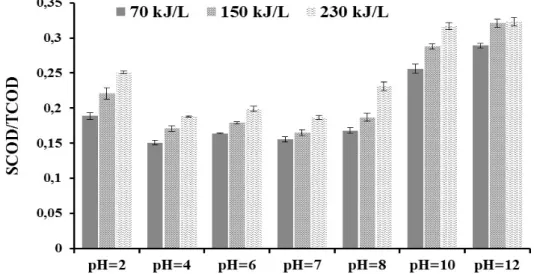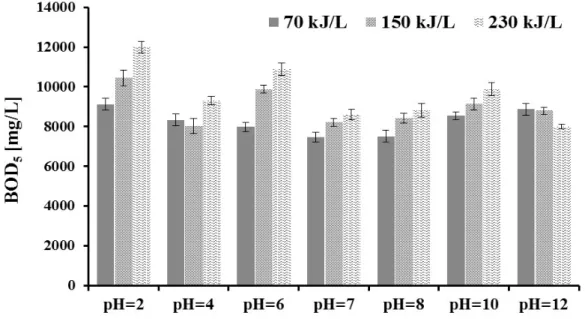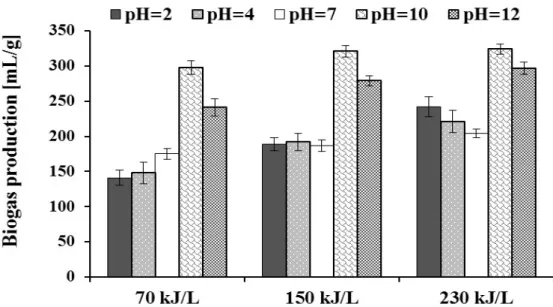ENHANCED BIODEGRADABILITY OF DAIRY SLUDGE BY MICROWAVE ASSISTED ALKALINE AND ACIDIC PRE-TREATMENTS
SÁNDOR BESZÉDES,ZOLTÁN JÁKÓI,BALÁZS LEMMER,CECILIA HODÚR
University of Szeged Faculty of Engineering Institute of Process Engineering Moszkvai krt. 9, H-6725 Szeged, Hungary
beszedes@mk.u-szeged.hu
ABSTRACT
Considering the rapid, volumetric and selective heating effects of microwaves the microwave assisted chemical methods could provide appropriate alternatives for conventional thermal methods in sludge processing. Microwave irradiation alone is suitable to accelerate the hydrolysis stage of anaerobic decomposition of sludge resulted in accelerated biogas production rate and in higher biogas yield. Alkaline pre-treatments increase the organic matter solubility and suitable for disintegration of sludge particles. In some study are concluded that acidic conditions help the disintegration of waste activated sludge and assist in the solubilisation of carbohydrates and proteins which led to increased higher biogas production, as well.
Beside the promising results related to effects of microwave pre-treatments on anaerobic digestion of sludge there are very few reports on the investigation of combined acidic/alkali-microwave pre-treatment method for food industry originated sludge. Hence, our study focused on the examination of the effects of combined microwave-alkali and microwave-acidic pre-treatment on aerobic and anaerobic biodegradability of sludge produced in dairy industry
Our experimental results verified, that microwave irradiation with alkaline dosage improve the solubility of organic matters in the pH range of 8-12. But enhancement of disintegration was not correlated linearly with biodegradability. During pre-treatment stage, applying pH over 10, the aerobic biodegradability show decreasing tendency. Applying of acidic condition during microwave irradiation resulted in lower disintegration degree than obtained for microwave-alkaline sludge pre-treatment method. But with microwave assisted acidic pre-treatments a higher aerobic biodegradability could be achieved than with alkaline dosage. In microwave pre-treatments acidic condition was preferable to increase the shorter aerobic biodegradability; the alkaline condition was favourable to intensify the anaerobic digestion process.
Keywords: microwave, biodegradability, dairy sludge, pre-treatments
INTRODUCTION
Continuously increasing amount of sludge produced from municipal and industrial wastewater has been become one of the main practical problem for wastewater treatment plants. Among the stabilization methods anaerobic digestion (AD) is the main commonly used process. AD is suitable to reduce the amount of solids for disposal, mitigate the odour problems of sludge, other waste biomass can be handled co-digested with sludge, the final output stream, i.e. digested sludge, is beneficial for plant growth, and green energy is produced in the form of biogas (YANGET AL., 2010).
In most cases efficient pre-treatment is need before AD to decrease the amount of aerobic microorganisms and make more susceptible the organic matters for biodegradation.
Among possibly utilizable methods, the applicability of microwave irradiation prior to the AD has been investigated in the last decade. Microwave (MW) irradiation is an alternative method for the commonly used thermal treatment, in many cases is considered to be more effective than conventional heating methods (TYAGI AND LO, 2013). High energy intensity, volumetric heating effect and low loss of energy transmission led to rapid heating directly in the processed material. Change of dipolar orientation of polar side chains of macromolecules in electromagnetic field can manifest in unfolding of complex molecules,
or breakage of hydrogen bonds (AFOLABI AND SOHAIL, 2017). Application of thermal treatments can be limited by the denaturation for protein contented effluents and sludge.
Heating time and temperature affects mainly the degree of denaturation, but the heat sensitivity of proteins is influenced by the pH and ionic strength, as well.
Because the chemical pre-treatments have also verified positive effect on biodegradability, combination of the two process category could be promising. In general, alkaline treatment, especially if it is associated by thermal methods, suitable to increase the disintegration, accelerate the anaerobic digestion and enhance the biogas production, as well (DOGANAND SANIN, 2009). Compared to other methods, alkaline pre-treatments have many advantages, i.e. simple equipment, easy to operate and control, and high efficiency.
Most of the investigations concluded increase in biogas producement and a decreasing tendency in volatile suspended solids concentration. On the other hand, it has also been concluded that sludge treatment at pH of 10.0 could inhibit the activity of methanogen bacteria resulted in higher volatile fatty acid production.
There can be found some studies where the efficiency of acidic sludge pre-treatments is investigated. DEVLIN ET AL. (2011) verified that pre-treatment of municipal WAS under acidic condition led to 4-6 times increment of carbohydrate and protein solubility, respectively. In batch mesophilic AD tests biogas production increased by 17% and 32% if acidic treatments were carried out at pH 2 and pH 1, respectively. Dosed acids reduce the negative charge of sludge particles interfere the forming of larger floc, therefore the ratio of bounded water closed into particles decrease, as well.
Combine the thermal and chemical sludge pre-treatments could be effective at lower temperature ranges considering the energy demand of pre-treatment process. It is verified that thermal pretreatments, applied them alone, at the temperature range below 100 °C was not sufficient to achieve the total degradation of complex molecules, but thermal effects were enough to induce deflocculation of macromolecules (PROTOTET AL., 2011). Applying of thermochemical pre-treatments at temperature range of 70-90 °C enhanced of solubilization of proteins and increased removal of particulate carbohydrates can be observed (BESZÉDESET AL., 2009). Combination of alkaline dosage with thermal treatment the surface area of sludge flocks increases and the organic substrates are more accessible to the anaerobic microbes. During thermos-alkaline treatment the effect of acidic components of sludge can be moderated via neutralization, which is advantageous considering the optimal pH range of AD. In acidic pre-treatments is needed to investigate the compounds of processed materials. Optimal pH of pre-treatments is depended on the isoelectric point in protein contented materials. A potential disadvantage of applying acidic condition during pre-treatments is the loss of fermentable sugar due to the increased degradation of the complex substrates.
Acidic and alkaline dosage affects the rate and the efficiency of biological degradation indirect way, as well, because the alkalization, or the neutralization after acidic pre- treatment is commonly carried out by using NaOH and/or KOH, respectively. Using of acid or alkali addition accompanying ions has been presented in sludge, therefore the theoretically high biodegradability of municipal and food industrial sludge is limited. It has been verified, that sodium ions in a concentration of above 5 g/L inhibit the anaerobic degradation, because the sodium is toxic to the bacteria utilizing the propionic acid.
Anaerobic microbes are more tolerant to the potassium ion concentration, but over potassium concentration of 8g/L the anaerobic decomposition has been became inhibited.
Lower inhibitory effect of potassium ions is observed over a concentration of 0.8 g/L, especially under thermophilic condition (KIMET AL., 2000).
MATERIAL AND METHOD
Sludge samples processed by microwave pre-treatment originated from a dairy work. Dairy sludge has a total solid (TS) and chemical oxygen demand (COD) of 6.8 ± 0.3 w%, and 18900 ± 680 mg/L, respectively. Initial pH of raw dairy sludge was measured as 6.2 ± 0.3.
Total solid content (TS) was measured by drying to constant weight at 105 °C. COD was measured by colorimetric standard method (APHA, 2005). Biochemical oxygen demand tests (BOD) were carried out in a respirometric BOD system (BOD Oxidirect, Lovibond, Germany) at 20 °C for 5 days.
Anaerobic digestion (AD) tests were carried out triplicated in continuously stirred laboratory scale reactors with volume of 250 mL equipped by Oxitop-C measuring head applying pressure operating mode (WTW GmbH, Germany). Seed sludge originated from an aerobic digester of the local municipal wastewater treatment plant. After microwave pre-treatments pH of the mixed sludge was adjusted to 7.6, temperature was thermostated at 37±0.2 ˚C for 30 days.
Microwave pre-treatment was carried out in a tailor-made microwave unit equipped with variable power magnetron (from 100 W to 850 W) operating at frequency of 2450 MHz. In the continuously flow operation mode the volumetric flow rate of irradiated samples can be varied by the revolution of peristaltic pump in the range of 6-35 L/h. The sludge was flow through a toroidal pipe in microwave unit. The specific irradiated microwave energy was determined as the product of magnetron power and residence time of processed material in the microwave unit. During the pre-treatments the pH of sludge was adjusted by NaOH and hydrochloric acid, respectively.
RESULTS AND DISCUSSION
In the first stage of the research the disintegration effect of microwave was investigated at different pH using different energy intensity. Disintegration degree was given by the ratio of organic matter measured by COD from soluble phase (SCOD) to the COD measured from total sludge matrix (TCOD). Our results show that at a given pH increasing of irradiated MW energy led to enhanced disintegration degree (Figure 1).
Figure 1. Ratio of soluble to total COD at different pH and irradiated energy levels
Considering the effect of pH adjusted for MW pre-treatment on disintegration degree can be concluded that compare to the treatment at neutral pH, acidic condition could increase the solubility of organic matters, especially if irradiated energy was set to higher level (230 kJ/L), but alkaline treatment assisted by microwave irradiation was more favourable. Initial SCOD/TCOD for raw dairy sludge was determined as 0.14, applied MW-alkaline treatment it is increased above 0.3 (Figure 1).
Disintegration degree is commonly used parameter to measure the efficiency of different sludge treatment processes. But biodegradability is not directly and linearly correlate with the change of organic matter solubility. Therefore, BOD measurements were carried out to determine the biodegradability of pre-treated sludge under aerobic condition. Considering the change of BOD it can be established, that though alkaline condition during MW irradiation could increase the aerobic biodegradability compare it to the MW irradiated sample at neutral pH, but applying acidic condition in MW treatment results in higher BOD (Figure 2). The initial BOD of raw sludge (6350 ± 390 mg/L) increased by near 90%
if 230 kJ/L microwave irradiation was used at pH 2.
Figure 2. BOD at different pH and irradiated energy levels
It can be observed that the tendency of the change of BOD at acidic condition has been broken at pH 4, especially if energy intensity of MW irradiation was 150 kJ/L, and 230 kJ/L. This breaking point suggested to cause by the isoelectric point of casein, lactalbumin and lactoglobulin content of dairy sludge, which is the pH range of 4-5. It was also found, that by strong alkaline condition (pH=12) increasing of energy irradiation from 70 kJ/L to 230 kJ/L could decrease the biodegradability under aerobic condition (Figure 2).
For sludge utilization the anaerobic digestion processes are commonly used, mainly in mesophilic temperature range. Therefore, the biogas production of different pre-treated dairy sludge was also determined. Results related to biogas yield (given by the volume of produced biogas specified to gram dry matter of sludge) show unambiguously, that differ from the tendency observable for the change of aerobic biodegradability, alkaline condition applied during MW pre-retreatments of dairy sludge was more advantageous that acidic condition.
At every MW energy intensity level the biogas production of alkaline pre-treated samples were higher, than that of obtained for acidic pre-treated sludge. Compared to the biogas yield of raw sludge (152 ± 18 mL/g) the microwave assisted alkaline treatment enhanced the biogas production to above 300 mL/g (Figure 3).
3
Figure 3. Biogas production of pre-treated dairy sludge
At a given pH increment in energy intensity of MW irradiation led to higher biogas yield.
Similarly, to the change of BOD, it can be observed, that increase the alkaline dosage to above pH 10 resulted in worsening effect.
CONCLUSIONS
The aim of our research was to investigate the effect of microwave assisted acidic and alkaline pre-treatment on biodegradability of dairy sludge under aerobic and anaerobic condition, respectively. Experiments was carried out in a continuously flow microwave processor unit with different irradiated energy intensity. It can be concluded that acidification and alkalization of dairy sludge are also suitable to achieve enhanced disintegration degree and biodegradability.
Our results show that for enhanced disintegration and anaerobic digestion the alkaline condition can be recommended. Disintegration degree achievable by microwave intensified alkaline treatment was 30% higher than that of it measured for acidified sludge. Applying of microwave-alkaline pre-treatment the biogas yield increased from 152 mL/g to above 300 mL/g in the MW intensity range of 70-230 kJ/L. But it was found, that from the aspects of shorter time aerobic biodegradation the acidic condition applied during microwave irradiation was more favorable.
ACKNOWLEDGEMENTS
The authors are grateful for the financial support provided by the NKFIH under project number K115691. This project was supported by the János Bolyai Research Scholarship of the Hungarian Academy of Sciences (MTA), the UNKP-17-4-I-SZTE-5 New National
Excellence Program of the Ministry of Human Capacities and EFOP-3.6.2-16-2017- 00010–RING 2017.
REFERENCES
AFOLABI, O.D., SOHAIL, M. (2017): Microwaving human faecal sludge as a viable sanitation technology option for treatment and value recovery-A critival review. J.
Environ. Manag., 187: 401-415.
BESZÉDES, S., LÁSZLÓ, Zs., SZABÓ, G., HODÚR, C. (2009): Examination of the effects of microwave heating on the biodegradable and solubler fraction of organic matter of sludge.
Annals. Fac. Eng. Hun. Int. J. Eng. 7(4): 87-90.
DEVLIN, D.C., ESTEVES, S.R.R., DINSDALE, R.M., et al., (2011): The effect of acid pretreatment on the anaerobic digestion and dewatering of waste activated sludge.
Bioresour. Technol. 102: 4076–4082.
DOGAN, I., SANIN, F.D. (2009): Alkaline solubilization and microwave irradiation as a combined sludge disintegration and minimization method. Water Res. 43(8): 2139–2148.
KIM, I.S., KIM, D.H., HYUN, S.H. (2000): Effect of particle size and sodium ion concentration on anaerobic thermophilic food waste digestion. Water Sci Technol 41: 67–
73.
PROTOT, A., JULIEN, L., CHRISTOPHE, D., PATRICK, L. (2011): Sludge disintegration during heat treatment at low temperature: a better understanding of involved mechanisms with a multi-parametric approach. Biochem Eng J 54: 178–84.
TYAGI, V.K., LO, S-L. (2013): Microwave irradiation: A sustainable way for sludge treatment and resource recovery. Renew. Sustain. Energy Rev. 18: 288-305.
YANG, X.Y., WANG, X., WANG,L. (2010): Transferring of components and energy output in industrial sewage sludge disposal by thermal pretreatment and two-phase anaerobic process. Biores. Technol. 101(8): 2580–2584.


